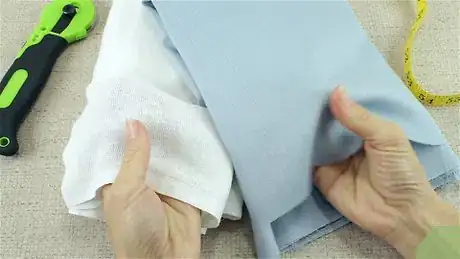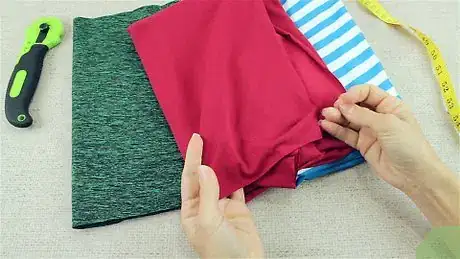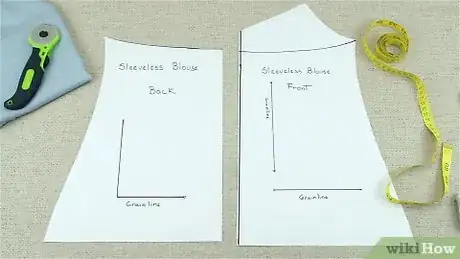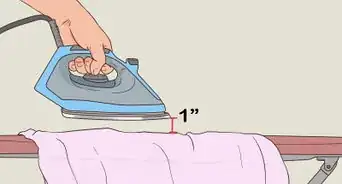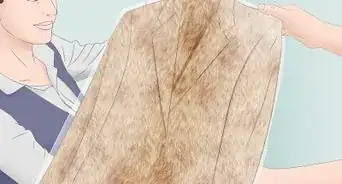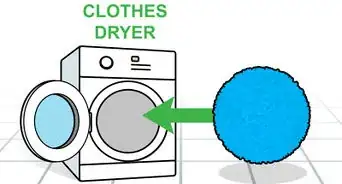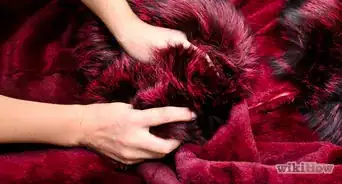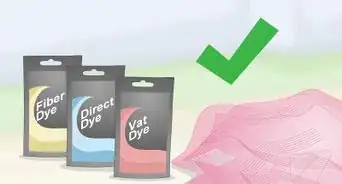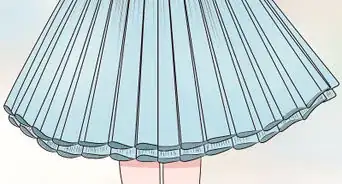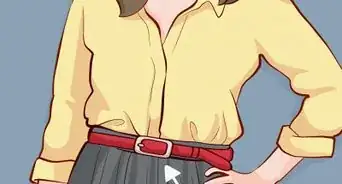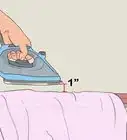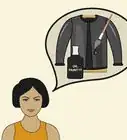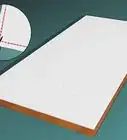This article was co-authored by Kpoene Kofi-Bruce and by wikiHow staff writer, Jessica Gibson. Kpoene Kofi-Bruce is a tailor, couture wedding gown designer, and the Creative Director of Mignonette Bridal and Ette the Wedding Tailor in Chicago, Illinois. With nearly two decades of experience as a wedding gown designer, small business owner, and vintage sewing enthusiast, Kpoene specializes in wedding gown design and the social history of wedding dresses. She received a BA in Creative Writing from Middlebury College and studied the business of fashion at the Fashion Institute of Technology. She is also a graduate of the Goldman Sachs 10KSB program and the Chicago Fashion Incubator and has written about wedding fashion for Jezebel, Catalyst, the Sun Times, and XO Jane.
This article has been viewed 11,025 times.
If you'd like to take your sewing to the next level, learn to cut fabric so it drapes and contours to your body. Cutting on the bias means placing your pattern at a 45-degree angle to the straight grain. You'll cut the fabric at a diagonal angle so it falls more naturally when you sew the item. Keep in mind that because you're positioning the fabric pieces at an angle, you'll need more fabric and you won't be able to cut the pieces on the fold.
Steps
Selecting the Fabric and Pattern
-
1Choose a woven fabric in a solid or all-over print. Always know where your grain line is, since you're relying on the length of the grain and the cross of the grain to find the diagonal angle of the bias, you'll need woven fabric.[1] Pick a solid color or a print that doesn't have to line up, such as polka dots.[2]
- Look for fabric that's easy to handle, such as cotton, plain weave linen, or wool challis fabric.
-
2Avoid using non-woven or heavy canvas fabrics. Don't select stretchy, slippery, heavy, or stiff fabrics since these will be difficult to cut or they'll stretch too much. Keep in mind that you won't be able to find the bias if you're using fabric that wasn't woven. In general, don't cut any of these fabrics on the bias:[3]
- Heavy-weight canvas
- Twill
- Stretch fabric
- Rayon
- Poplin
Tip: Although skilled sewers can cut complicated patterns on the bias, you should avoid cutting fabric with stripes or plaid until you're comfortable. This is because you'll have to carefully match the stripes so the fabric pieces line up correctly.
Advertisement -
3Pick a simple pattern to help you get comfortable with sewing on the bias. Since you really want to highlight the natural drape of the fabric, choose a sewing pattern that's simple and doesn't rely on darts, hooks, or closures for shaping. This will allow you to focus on properly cutting the fabric and assembling the garment.[4]
- For example, choose a pattern for a camisole, woven T-shirt, or wrap skirt.
Cutting the Pattern on Your Fabric
-
1Cut out full pattern pieces. Unfold your pattern and use scissors to cut out each pattern piece.[5] If the pieces are meant to be placed on the fold, cut out the piece and place it on a larger sheet of pattern paper. Trace around the piece using a fabric marker and flip it over the center line. Then, trace around the other side before you cut out the full piece.[6]
- If the pattern pieces are full and not meant to be placed on the fold, you can begin arranging them on the fabric.
-
2Use a 45-degree ruler to mark the bias in the middle of each pattern piece. Most pattern pieces will include lines that show the cross grain and the straight grain. Instead of using these lines, place a 45-degree ruler in the center of these lines. Then, draw a line that extends diagonally from the center of these lines. Make the bias lines the same length as the grain lines on the pattern.[7]
- You can buy a 45-degree ruler at art, quilt, or craft supply stores.
-
3Lay your fabric out in a single layer. You may be familiar with folding your fabric and placing the pattern pieces on the fold. Unfortunately, this would cause your fabric piece to be cut from 2 different angles. Lay the fabric out completely flat on your cutting mat so it's facing right-side up.[8]
- Since you can't fold the fabric, you'll need a large work surface for cutting the pieces.
-
4Place the pattern pieces on the fabric so the biases are perpendicular. Arrange the full pattern pieces so the bias line for each piece is perpendicular to the next piece's bias line. This means that the bias lines should form a 90-degree angle.[9]
- If you place the pieces so the bias lines are parallel, the garment will twist and wrap around you awkwardly.
- If you're worried that the pattern pieces will slide around, place fabric weights on them.[10]
- Cutting the pieces on perpendicular biases will also prevent the side seams from being crooked when you sew the garment.
-
5Use a rotary cutter to cut about 1 inch (2.5 cm) beyond the cutting line. Cutting on the bias takes up more fabric, especially for your seam allowances. Instead of cutting directly along the pattern pieces, use the rotary cutter to cut 1 inch (2.5 cm) past the pattern piece.[11]
- Cut around each pattern piece so you're ready to sew your garment.
Tip: Although you could use scissors, you're more likely to pull and stretch the fabric as you cut. This is why a rotary cutter is the best tool for cutting fabric on the bias.
Expert Q&A
-
QuestionWhat are the different techniques when cutting fabric?
 Kpoene Kofi-BruceKpoene Kofi-Bruce is a tailor, couture wedding gown designer, and the Creative Director of Mignonette Bridal and Ette the Wedding Tailor in Chicago, Illinois. With nearly two decades of experience as a wedding gown designer, small business owner, and vintage sewing enthusiast, Kpoene specializes in wedding gown design and the social history of wedding dresses. She received a BA in Creative Writing from Middlebury College and studied the business of fashion at the Fashion Institute of Technology. She is also a graduate of the Goldman Sachs 10KSB program and the Chicago Fashion Incubator and has written about wedding fashion for Jezebel, Catalyst, the Sun Times, and XO Jane.
Kpoene Kofi-BruceKpoene Kofi-Bruce is a tailor, couture wedding gown designer, and the Creative Director of Mignonette Bridal and Ette the Wedding Tailor in Chicago, Illinois. With nearly two decades of experience as a wedding gown designer, small business owner, and vintage sewing enthusiast, Kpoene specializes in wedding gown design and the social history of wedding dresses. She received a BA in Creative Writing from Middlebury College and studied the business of fashion at the Fashion Institute of Technology. She is also a graduate of the Goldman Sachs 10KSB program and the Chicago Fashion Incubator and has written about wedding fashion for Jezebel, Catalyst, the Sun Times, and XO Jane.
Couture Bridal Designer Always know where your grain line is, make sure you have good sharp scissors, and utilize fabric weights or pins. For items like silk satin or flimsy fabrics, making sure the fabric doesn’t shift as you cut it is crucial for best results. Patience while cutting is also a must. Cutting is my least favorite part because I am so anxious to get started sewing, but you will quickly find that patience during this step equals great results!
Always know where your grain line is, make sure you have good sharp scissors, and utilize fabric weights or pins. For items like silk satin or flimsy fabrics, making sure the fabric doesn’t shift as you cut it is crucial for best results. Patience while cutting is also a must. Cutting is my least favorite part because I am so anxious to get started sewing, but you will quickly find that patience during this step equals great results!
Things You'll Need
- Woven fabric
- Pattern
- Fabric marker
- Scissors
- Rotary cutter
- Cutting mat
- 45-degree angle ruler
- Fabric weights, optional
References
- ↑ Kpoene Kofi-Bruce. Couture Bridal Designer. Expert Interview. 28 January 2021.
- ↑ https://sewguide.com/grainline-of-a-fabric/
- ↑ https://sewguide.com/cutting-sewing-fabric-on-the-bias/
- ↑ https://youtu.be/cjqqxM0H0iA?t=91
- ↑ Kpoene Kofi-Bruce. Couture Bridal Designer. Expert Interview. 28 January 2021.
- ↑ https://youtu.be/cjqqxM0H0iA?t=168
- ↑ https://sewguide.com/cutting-sewing-fabric-on-the-bias/
- ↑ https://sewguide.com/cutting-sewing-fabric-on-the-bias/
- ↑ https://youtu.be/cjqqxM0H0iA?t=222
- ↑ Kpoene Kofi-Bruce. Couture Bridal Designer. Expert Interview. 28 January 2021.
- ↑ https://sewguide.com/cutting-sewing-fabric-on-the-bias/
